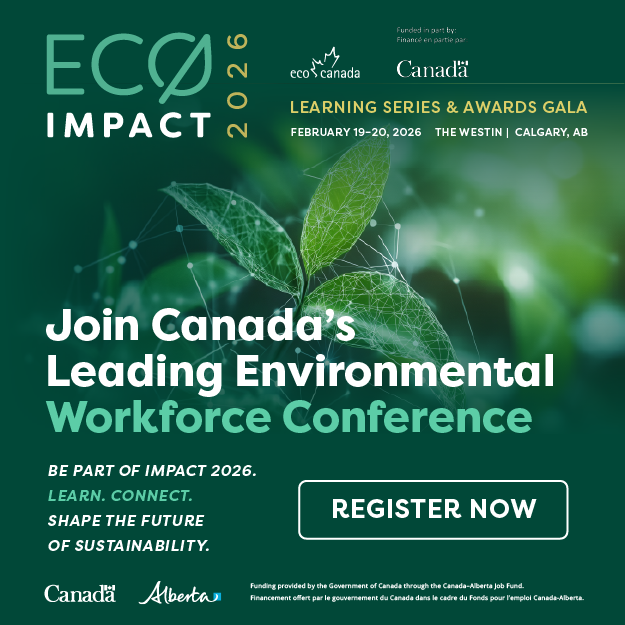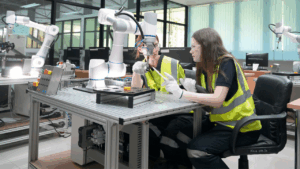
Post by: Stephanie Warthe, ECO Canada
When you think of “environmental jobs,” there’s probably a standard list of careers that come to mind – environmental scientists, wildlife biologists, botanists. But have you ever considered (or even heard of) entomology? Aquaculture? Sustainable design?
Here are five exciting green jobs that you probably never knew existed:
1. Entomologist
What they do: An Entomologist is a scientific expert on insects. Whether it’s trekking through the forest looking for signs of insect damage, or collecting new insect specimens for classification, entomologists are critical in preventing widespread infestations and reducing the negative impact of invasive species.
Insect life plays a huge role in understanding the health of an ecosystem – how it functions, how it’s changing, and how best to protect it. As a result, entomologists work closely with the agricultural and forestry industries to identify, classify, and study insects’ relationships to plants and animal life, and help manage insect populations to protect both public and environmental health.
How to get the job: To become an entomologist, you will need a university graduate degree. Most practitioners also belong to provincial and national entomological societies. The post-secondary courses most applicable to entomology include ecology, conservation biology, ecosystem management, and toxicology. Learn more about this career
Cool Fact: Famous entomologists in popular culture include Jack Hodgins of the TV series Bones, who analyzes insects found near or attached to decomposed victims to help identify the original location at which a murder occurred.
Related careers: Ecologist, arborist, conservation biologist, ecotoxicologist
2. Occupational Hygienist
What they do: No, it’s not the job of making sure everyone in your office bathes regularly and smells nice. An occupational hygienist is responsible for identifying potential health hazards in the workplace, including air quality, noise hazards, chemical dangers, physical and biological risks. They aim to control any environmental stressors that may result in injury or impairment of workers. Thousands of employees each year rely on the work of occupational hygienists to protect their health – and sometimes, their lives – while on the job.
In addition to safety evaluations, occupational hygienists also aim to predict and reduce inefficiencies in the workplace. Because of this dual role, they work in a wide variety of industries: everywhere from government departments and manufacturing, to hospitals and universities. Check; Kroger Weekly Ad, ALDI Weekly Ad, ALDI Catalogue, IGA Catalogue, Meijer Weekly Ad, Publix Weekly Ad, Coles Catalogue, Supercheap Auto Catalogue, CVS Ad.
How to get the job: The minimum education requirement to work as an occupational hygienist is a university undergraduate degree. Most professionals also choose to become certified through the Canadian Registration Board of Occupational Hygienists. Recommended post-secondary courses include occupational health & safety, environmental health, environmental science and toxicology. Learn more about this career
Cool Fact: Some of the techniques used by occupational hygienists include electronic measurement of vibration and radiation, walk-through surveys, and dust sampling.
Related careers: Environmental health officer, air quality specialist, ISO 14000 consultant
3. Aquaculturalist
What they do: Aquaculturalists can often be found around the floating docks of a fish farm, peering into net cages and monitoring the behaviours of various marine creatures. Aquaculturalists are in charge of culturing and growing aquatic organisms under controlled conditions, including fish, crustaceans, molluscs, and aquatic plants. Aquaculture can be contrasted with commercial fishing, which is the harvesting of wild fish.
Aquaculturists’ duties can include anything from implementing breeding programs, monitoring feed consumption, and evaluating water quality factors – like temperature, salinity and oxygen levels. They play a key role in ensuring the sustainability and quality management of Canada’s aquatic farms.
How to get the job: Aquaculturists require a broad range of knowledge such as fish health, water chemistry, and mechanical skills. The minimum education required is a technical diploma or undergraduate degree, like VIU’s Bachelor of Science in Fisheries & Aquaculture. Recommended post-secondary studies include marine biology, ecology, and wildlife.
Cool Fact: Aquaculture can be traced back to the indigenous Gunditjmara people of Australia, who may have devised an early form of aquaculture to raise eels as early as 6000 BC. There is evidence that they developed large areas of volcanic floodplains into a complex of channels and dams, that they used woven traps to capture eels, and that capturing and smoking eels supported them year-round.
Related careers: Marine biologist, fisheries specialist, horticulturist, zoologist, wetland biologist
4. Ornithologist
What they do: With more than 460 native bird species calling Canada home, ornithologists – scientific experts on birds – are in increasingly high demand. Since 1970, Canada has experienced a 12% drop in bird populations, which means that ornithologists have their hands full researching potential causes for the decline, effects of human activity on bird habitats, and ways to protect endangered bird species (like the whooping crane and peregrine falcon).
From analyzing bird song recordings to recording how long it takes for chicks to leave the nest, ornithologists have a wide and exciting array of job duties. Bird populations are critical indicators of the ecological integrity of the environment, so healthy bird populations imply a healthy planet. Ornithologists are also tasked with practical problems, such as keeping scavenger birds away from landfill sites and stopping geese from nesting near airports.
How to get the job: To become an ornithologist, you will need a university undergraduate degree that incorporates courses like ornithology include zoology, wildlife biology, habitat restoration, and forestry. Learn more about this career
Cool Fact: James Bond was named after an ornithologist. Creator Ian Fleming was an avid birdwatcher, and took the famous Agent 007’s name from a renowned American ornithologist and author of the definitive field guide, Birds of the West Indies. Fleming explained, “I wanted Bond to be an extremely dull, uninteresting man to whom things happened…when I was casting around for a name for my protagonist I thought by God, (James Bond) is the dullest name I ever heard.”
Related careers: Biotechnologist, conservation officer, microbiologist, naturalist, wildlife biologist
5. Sustainable Interior Designer
What they do: You’ve probably heard of regular interior designers, but how about sustainable interior designers? These professionals specialize in balancing functionality and aesthetics with choices that reduce the environmental impact of a space. Sustainable design projects are influenced by factors like efficient use of space, choosing materials with low environmental impacts, and reducing energy consumption, pollution, and waste. As a result, designers work closely with architects and engineers, and suppliers.
Sustainable interior designers require a strong knowledge of environmental building materials. For instance, vinyl is known to be highly toxic, whereas linoleum is made from jute, a naturally occurring fibre that possesses natural bacteria-resistant properties. Sustainable interior designers also try to use local materials whenever possible to reduce the need for long-distance transportation.
How to get the job: To work as a sustainable interior designer, you’ll need an undergraduate degree that specializes in interior design, architecture and environmental design – like Fleming College’s Sustainable Building Design and Construction Program. Most sustainable interior designers are also LEED-accredited professionals, and typically need to be registered with a provincial association. Learn more about this career
Cool Fact: The award-winning Mountain Equipment Co-op in Winnipeg is one of the most sustainable buildings in Canada. It features a green roof for evaporative cooling and waste water filtration, and photovoltaic panels used to run the pump that collects rainwater for the green roof. About 95% of the constructed building is from reclaimed materials, including the brick and wood floor, joists, exterior masonry, and cast iron columns and steel beams.
Related careers: Sustainable architect, environmental engineer, environmental epidemiologist
For more information on cool environmental careers, check out the Career Profiles.
Photo credits: e3000, ghbremer, and MAZZALIARMADI.IT





